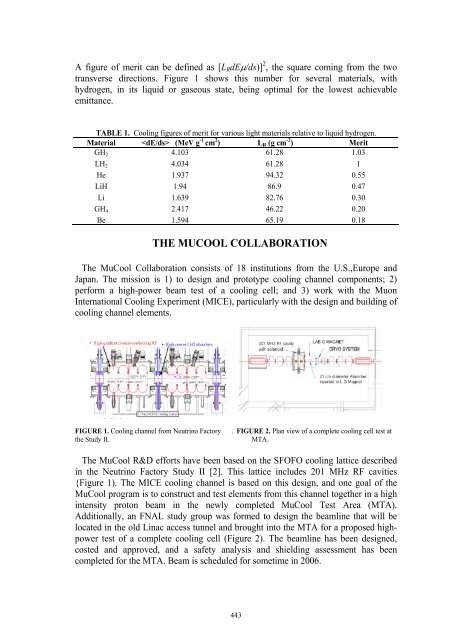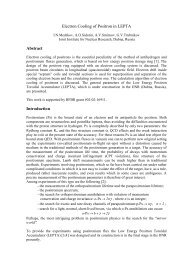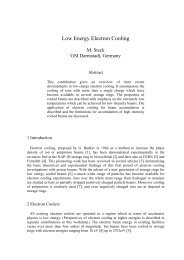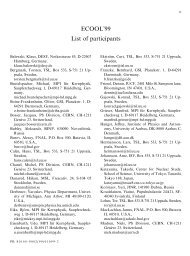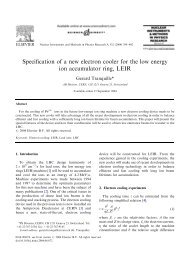Mucool Hydrogen Absorber R&D - BETACOOL home page
Mucool Hydrogen Absorber R&D - BETACOOL home page
Mucool Hydrogen Absorber R&D - BETACOOL home page
Create successful ePaper yourself
Turn your PDF publications into a flip-book with our unique Google optimized e-Paper software.
A figure of merit can be defined as [LRdEµ/ds)] 2 , the square coming from the two<br />
transverse directions. Figure 1 shows this number for several materials, with<br />
hydrogen, in its liquid or gaseous state, being optimal for the lowest achievable<br />
emittance.<br />
TABLE 1. Cooling figures of merit for various light materials relative to liquid hydrogen.<br />
Material (MeV g -1 cm 2 ) LR (g cm -2 ) Merit<br />
GH2 4.103 61.28 1.03<br />
LH2 4.034 61.28 1<br />
He 1.937 94.32 0.55<br />
LiH 1.94 86.9 0.47<br />
Li 1.639 82.76 0.30<br />
GH4 2.417 46.22 0.20<br />
Be 1.594 65.19 0.18<br />
THE MUCOOL COLLABORATION<br />
The MuCool Collaboration consists of 18 institutions from the U.S.,Europe and<br />
Japan. The mission is 1) to design and prototype cooling channel components; 2)<br />
perform a high-power beam test of a cooling cell; and 3) work with the Muon<br />
International Cooling Experiment (MICE), particularly with the design and building of<br />
cooling channel elements.<br />
FIGURE 1. Cooling channel from Neutrino Factory . FIGURE 2. Plan view of a complete cooling cell test at<br />
the Study II. MTA.<br />
The MuCool R&D efforts have been based on the SFOFO cooling lattice described<br />
in the Neutrino Factory Study II [2]. This lattice includes 201 MHz RF cavities<br />
{Figure 1). The MICE cooling channel is based on this design, and one goal of the<br />
MuCool program is to construct and test elements from this channel together in a high<br />
intensity proton beam in the newly completed MuCool Test Area (MTA).<br />
Additionally, an FNAL study group was formed to design the beamline that will be<br />
located in the old Linac access tunnel and brought into the MTA for a proposed highpower<br />
test of a complete cooling cell (Figure 2). The beamline has been designed,<br />
costed and approved, and a safety analysis and shielding assessment has been<br />
completed for the MTA. Beam is scheduled for sometime in 2006.<br />
443


